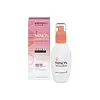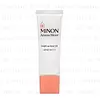What's inside
What's inside
 Key Ingredients
Key Ingredients

 Benefits
Benefits

 Concerns
Concerns

 Ingredients Side-by-side
Ingredients Side-by-side

Water
Skin ConditioningGlycerin
HumectantButylene Glycol
HumectantPropanediol
SolventMethyl Gluceth-20
HumectantPEG-75
HumectantSerine
MaskingBetaine
HumectantSodium Citrate
BufferingDipotassium Glycyrrhizate
HumectantPEG-50 Hydrogenated Castor Oil Triisostearate
EmulsifyingPhytosteryl/Octyldodecyl Lauroyl Glutamate
Skin ConditioningPhenoxyethanol
PreservativeArginine
MaskingCitric Acid
BufferingPEG-60 Hydrogenated Castor Oil
EmulsifyingTocopherol
AntioxidantSodium PCA
HumectantAlanine
MaskingLysine Hcl
Skin ConditioningPCA Ethyl Cocoyl Arginate
MoisturisingGlycine
BufferingCeteth-20
CleansingThreonine
Valine
MaskingHistidine
HumectantProline
Skin ConditioningLeucine
Skin ConditioningPentasodium Pentetate
Carnosine
Skin ConditioningPolyquaternium-61
Skin Conditioning1,2-Hexanediol
Skin ConditioningHydrogenated Lecithin
EmulsifyingPolyglyceryl-10 Laurate
Skin ConditioningSodium Hyaluronate
HumectantHydrolyzed Hyaluronic Acid
HumectantWater, Glycerin, Butylene Glycol, Propanediol, Methyl Gluceth-20, PEG-75, Serine, Betaine, Sodium Citrate, Dipotassium Glycyrrhizate, PEG-50 Hydrogenated Castor Oil Triisostearate, Phytosteryl/Octyldodecyl Lauroyl Glutamate, Phenoxyethanol, Arginine, Citric Acid, PEG-60 Hydrogenated Castor Oil, Tocopherol, Sodium PCA, Alanine, Lysine Hcl, PCA Ethyl Cocoyl Arginate, Glycine, Ceteth-20, Threonine, Valine, Histidine, Proline, Leucine, Pentasodium Pentetate, Carnosine, Polyquaternium-61, 1,2-Hexanediol, Hydrogenated Lecithin, Polyglyceryl-10 Laurate, Sodium Hyaluronate, Hydrolyzed Hyaluronic Acid
Water
Skin ConditioningCyclopentasiloxane
EmollientTitanium Dioxide
Cosmetic ColorantDiphenylsiloxy Phenyl Trimethicone
Skin ConditioningPEG-9 Polydimethylsiloxyethyl Dimethicone
EmulsifyingOctyldodecyl Myristate
EmollientTriethylhexanoin
MaskingPentylene Glycol
Skin ConditioningButylene Glycol
HumectantCetyl PEG/PPG-10/1 Dimethicone
EmulsifyingDisteardimonium Hectorite
StabilisingTrimethylsiloxysilicate
EmollientLauroyl Lysine
Skin ConditioningVinyl Dimethicone/Methicone Silsesquioxane Crosspolymer
Zinc Chloride
AntimicrobialPotassium Hydroxide
BufferingStearic Acid
CleansingDipentaerythrityl Tri-Polyhydroxystearate
EmollientPhytosteryl/Octyldodecyl Lauroyl Glutamate
Skin ConditioningTribehenin
EmollientPhenoxyethanol
PreservativeVinyl Dimethicone/Lauryl Dimethicone Crosspolymer
Tocopherol
AntioxidantStearyl Glycyrrhetinate
Skin ConditioningMethicone
EmollientBifida Polysaccharide
HumectantPPG-12
Skin ConditioningSilica
AbrasiveLimnanthes Alba Seed Oil
Skin ConditioningCarnosine
Skin ConditioningTaurine
BufferingGlycerin
HumectantLysine Hcl
Skin ConditioningPolyquaternium-61
Skin ConditioningGlutamic Acid
HumectantGlycine
BufferingLeucine
Skin ConditioningHistidine Hcl
Skin ConditioningSerine
MaskingValine
MaskingTin Oxide
AbrasiveZinc Aspartate
Skin ConditioningThreonine
Alanine
MaskingIsoleucine
Skin ConditioningAllantoin
Skin ConditioningPhenylalanine
MaskingArginine
MaskingProline
Skin ConditioningTyrosine
MaskingAlginic Acid
Skin ConditioningDisodium Guanylate
EmollientTalc
AbrasiveDimethicone
EmollientBoron Nitride
AbsorbentCI 77492
Cosmetic ColorantWater, Cyclopentasiloxane, Titanium Dioxide, Diphenylsiloxy Phenyl Trimethicone, PEG-9 Polydimethylsiloxyethyl Dimethicone, Octyldodecyl Myristate, Triethylhexanoin, Pentylene Glycol, Butylene Glycol, Cetyl PEG/PPG-10/1 Dimethicone, Disteardimonium Hectorite, Trimethylsiloxysilicate, Lauroyl Lysine, Vinyl Dimethicone/Methicone Silsesquioxane Crosspolymer, Zinc Chloride, Potassium Hydroxide, Stearic Acid, Dipentaerythrityl Tri-Polyhydroxystearate, Phytosteryl/Octyldodecyl Lauroyl Glutamate, Tribehenin, Phenoxyethanol, Vinyl Dimethicone/Lauryl Dimethicone Crosspolymer, Tocopherol, Stearyl Glycyrrhetinate, Methicone, Bifida Polysaccharide, PPG-12, Silica, Limnanthes Alba Seed Oil, Carnosine, Taurine, Glycerin, Lysine Hcl, Polyquaternium-61, Glutamic Acid, Glycine, Leucine, Histidine Hcl, Serine, Valine, Tin Oxide, Zinc Aspartate, Threonine, Alanine, Isoleucine, Allantoin, Phenylalanine, Arginine, Proline, Tyrosine, Alginic Acid, Disodium Guanylate, Talc, Dimethicone, Boron Nitride, CI 77492
Ingredients Explained
These ingredients are found in both products.
Ingredients higher up in an ingredient list are typically present in a larger amount.
Alanine is an amino acid and is already found in the human body. Our skin uses alanine to build collagen, elastin, and keratin.
Arginine is an amino acid that is important for human development. Your body uses is it to produce hair keratin and skin collagen.
As a cosmetic ingredient, Arginine has antioxidant properties and can also help repair damaged skin. This ingredient is derived either synthetically or from animals.
Arginine isn't fungal acne safe when used in the presence of other lipids (fats, fatty acids, oils, esters, etc). Oils and fats occur naturally within the skin, so take caution when using Arginine if you're prone to fungal acne.
Learn more about ArginineButylene Glycol (or BG) is used within cosmetic products for a few different reasons:
Overall, Butylene Glycol is a safe and well-rounded ingredient that works well with other ingredients.
Though this ingredient works well with most skin types, some people with sensitive skin may experience a reaction such as allergic rashes, closed comedones, or itchiness.
Learn more about Butylene GlycolCarnosine is a dipeptide made from two amino acids.
This ingredient helps:
Glycation is the process of sugars binding to and damaging proteins. Too much sugar in our skin can lead to damaged collagen, contributing to factors of aging.
Carnosine is water-soluble and is not able to travel deeper layers of skin. This leads to some doubt about whether it can boost collagen in skin, since collagen is located in the deeper layers of skin.
Fun fact: Carnosine can be naturally found in our muscles and brain.
Learn more about CarnosineGlycerin is already naturally found in your skin. It helps moisturize and protect your skin.
A study from 2016 found glycerin to be more effective as a humectant than AHAs and hyaluronic acid.
As a humectant, it helps the skin stay hydrated by pulling moisture to your skin. The low molecular weight of glycerin allows it to pull moisture into the deeper layers of your skin.
Hydrated skin improves your skin barrier; Your skin barrier helps protect against irritants and bacteria.
Glycerin has also been found to have antimicrobial and antiviral properties. Due to these properties, glycerin is often used in wound and burn treatments.
In cosmetics, glycerin is usually derived from plants such as soybean or palm. However, it can also be sourced from animals, such as tallow or animal fat.
This ingredient is organic, colorless, odorless, and non-toxic.
Glycerin is the name for this ingredient in American English. British English uses Glycerol/Glycerine.
Learn more about GlycerinThis ingredient is an amino acid that helps build proteins and moisturizes skin. It is already present in our skin as our bodies produce them naturally.
Glycine already plays a role in helping keep our skin moisturized as amino acids transport moisture throughout our skin.
As collagen is made up of glycine and other amino acids, it is believed glycine may help our skin produce more collagen.
Learn more about GlycineWe don't have a description for Leucine yet.
Lysine HCl is an alpha amino acid salt.
Our skin uses amino acids as a precursor for building protein, and therefore keratins, collagen and elastin.
Phenoxyethanol is a preservative that has germicide, antimicrobial, and aromatic properties. Studies show that phenoxyethanol can prevent microbial growth. By itself, it has a scent that is similar to that of a rose.
It's often used in formulations along with Caprylyl Glycol to preserve the shelf life of products.
We don't have a description for Phytosteryl/Octyldodecyl Lauroyl Glutamate yet.
We don't have a description for Polyquaternium-61 yet.
Proline is an amino-acid. It helps moisturize the skin and plays an important role in creating proteins.
Our skin uses proline as one of the building blocks for producing collagen.
In medicine, proline is used as an osmoprotectant. This means it helps prevent oxidative degradation in other drugs.
Our bodies are able to produce proline naturally, but certain conditions may inhibit this production. In that case, proline can be obtained from eating egg whites, soy protein, dairy products, asparagus, mushrooms, and seaweed.
Learn more about ProlineSerine is an amino acid naturally found in our body. Our bodies use amino acids to create protein.
Amino-acids help give keep our skin hydrated. They play an important role in the skin barrier, which keeps the skin plump and firm.
Serine is a non-essential amino acid, meaning we don't need to obtain it from eating foods.
Learn more about SerineThreonine is an amino-acid. It helps hydrate the skin and has antioxidant benefits.
Our skin uses threonine for creating collagen and elastin. Humans are not able to create threonine and must get it through eating foods such as fish, lentils, poultry, sesame seeds, and more.
Tocopherol (also known as Vitamin E) is a common antioxidant used to help protect the skin from free-radicals and strengthen the skin barrier. It's also fat soluble - this means our skin is great at absorbing it.
Vitamin E also helps keep your natural skin lipids healthy. Your lipid skin barrier naturally consists of lipids, ceramides, and fatty acids. Vitamin E offers extra protection for your skin’s lipid barrier, keeping your skin healthy and nourished.
Another benefit is a bit of UV protection. Vitamin E helps reduce the damage caused by UVB rays. (It should not replace your sunscreen). Combining it with Vitamin C can decrease sunburned cells and hyperpigmentation after UV exposure.
You might have noticed Vitamin E + C often paired together. This is because it is great at stabilizing Vitamin C. Using the two together helps increase the effectiveness of both ingredients.
There are often claims that Vitamin E can reduce/prevent scarring, but these claims haven't been confirmed by scientific research.
Learn more about TocopherolValine is an essential amino acid. It is used by our bodies for tissue repair and muscle growth.
An essential amino acid is one in which our bodies cannot naturally produce so we must get them through diet. Foods such as eggs, dairy, red meat, and fish contain valine.
This ingredient can either be derived from an animal product or be synthetically created.
Learn more about ValineWater. It's the most common cosmetic ingredient of all. You'll usually see it at the top of ingredient lists, meaning that it makes up the largest part of the product.
So why is it so popular? Water most often acts as a solvent - this means that it helps dissolve other ingredients into the formulation.
You'll also recognize water as that liquid we all need to stay alive. If you see this, drink a glass of water. Stay hydrated!
Learn more about Water